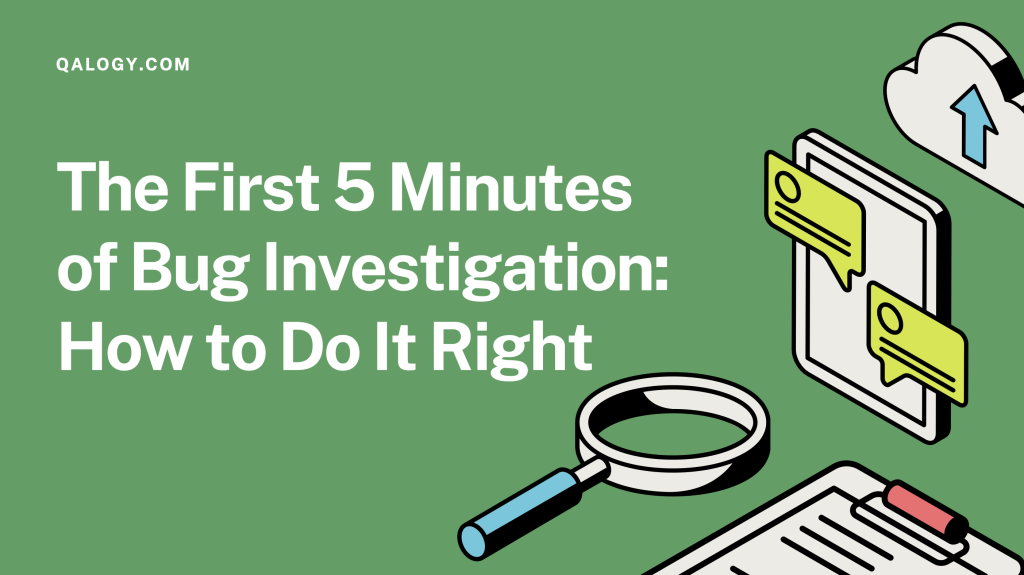There is one moment that every QA knows well… you are testing, and something behaves differently than expected. Suddenly, you’re staring at a bug that wasn’t supposed to exist. That first moment — those first five minutes of investigation — can determine whether you uncover the root cause quickly or get lost and waste time.
Bug investigation isn’t about panicking, guessing, or immediately running to create a ticket. The first few minutes are about gathering clarity, removing the unnecessary details, determining the cause, and understanding the behavior before it slips away. If you use these moments well, the rest of the investigation becomes faster, much more accurate, and you will save a lot of time.
So here is what you need to do during the first minutes of investigation:
Freeze the Moment
The very first step is to capture the state when the bug happened. Don’t click around randomly. Don’t refresh. Don’t restart anything yet.
Just observe the situation.
What exactly did the app do?
What did you expect?
What error did you see, if any?
What was the screen state?
What is the network state?
What is the orientation of the device? (if it’s a mobile device)
Are you currently logged in? (and with which user)
What were the last steps you performed?
This is the “crime scene” phase. Everything you see is a clue that will help us determine the right steps to reproduce the scenario.
At this point, it is useful to make a screenshot or a quick note just in case. Because sometimes it can happen that you will not be able to reproduce the bug with the steps that you thought were right, and you may forget some details of the state when the bug happened.
Try to Recreate the Conditions
In the second part of the process, we are talking about recreating the conditions. We are still not talking about reproducing the steps.
Reproduce the same situation that led to the bug:
- Same device or browser
- Same user account
- Same data inputs
- Same environment
- Same network conditions
- Same sequence of actions
- Same timing (yes, timing matters)
This is when you’re trying to answer the question:
Was this a one-off glitch or a pattern that needs to be investigated?
Many bugs depend on some conditions, like cache, state, network delays, or expired tokens. Recreating the scenario helps you see whether something external contributed to the failure.
Attempt a Clean Reproduction
After recreating the scenario in the exact same conditions, it is now time to try again with a fresh start.
To have a good, fresh start, you can do the following:
- Clear the cache if testing a web application.
- Restart the app if testing a mobile application.
- Log out and log in again.
- Reload the page.
- Use a new session or incognito tab.
This step removes any “noise” that might have triggered the bug earlier.
If the bug appears even in a clean environment, you are now dealing with something more stable — and that’s actually good news for investigation. It will make things easier.
If it doesn’t appear, the clue is clear:
The bug is linked to state, timing, or something leftover in the session.
That’s valuable information.
Look Behind the Curtain
By now, we were looking at how the app behaves on the surface. But it is also important to look underneath.
Check what the system is doing:
- Browser console logs
- Network requests
- Backend responses
- Error messages
- Status codes
- Any warnings or failed calls
You’re not trying to find the root cause, but you are looking for anything unusual that happened at the exact moment of the bug.
A 500 error?
A slow API?
A missing field?
A null value?
A client-side crash?
A repeated request loop?
Even if you don’t fully understand the technical reason, capturing this information now is gold when you document the bug or hand it over to developers.
Map the Pattern
When you have enough information, you can start forming the first hypothesis.
You’re answering questions like:
- When does the bug happen?
- When does it not happen?
- Is it related to data, timing, environment, or UI state?
- Is it consistent or intermittent?
- Does it break the entire flow or just part of it?
These early conclusions don’t need to be perfect — just directional. They’ll guide your deeper investigation or help you write a strong bug report.
A great bug ticket doesn’t start with “It doesn’t work.”
It starts with:
“Here’s when it happens, here’s when it doesn’t, and here’s the evidence.”
Minimize the Steps Until Only the Core Problem Remains
The goal of the investigation is to find the Minimal Reproducible Scenario — the shortest possible path that still makes the bug appear.
This is important because:
- It makes debugging easier for developers
- It helps isolate the root cause
- It removes noise from the bug report
- It makes the bug more reliable
- It saves everyone time
You don’t need a bug report in the following format (full with steps that are not necessary to reproduce the bug) :
“Click here, login, scroll, refresh, select item, click back, then click again and it breaks.”
You don’t need a bug report that will represent the shortest possible path that still makes the bug appear:
“Tap X → Tap Y → Bug appears.”
Test Variations to Understand Impact
As QAs, we shouldn’t just investigate the bug; we should also investigate the environment around it to understand the impact.
For this purpose, we can try different test variations, like:
- Different accounts
- Different data
- Different browsers
- Different states (logged in/out)
- Different speeds of interaction
- Different network quality
- Different paths to reach the same screen
This can help us determine the real priority of the bug.
Collect Evidence
When you finish with the investigation, make sure that you collect all the evidence. This will help the developers to easily reproduce the bug and to determine the root cause. It will also help after fixing the bug, by making the retesting easier and clearer.
You can collect various evidence, like:
- Environment information
- Screenshots
- Videos
- Browser console logs
- Network tab failures
- API responses
- Error codes
- Test data
- Timestamps
The Bottom Line
The next time you find a bug, don’t rush to report it immediately in Jira.
Don’t panic.
Don’t guess.
Because great QA isn’t about finding bugs. Great QA is about understanding them.
If you take a couple of minutes to investigate and follow these steps, you will have a lot of benefits. It will save you time, strengthen your bug reports, and help you truly understand what’s happening.
And once you’ve gathered all the info, here’s what to do before opening a bug ticket.


